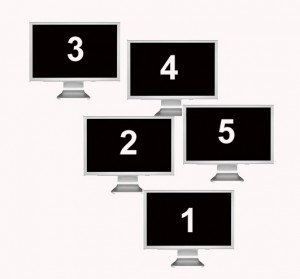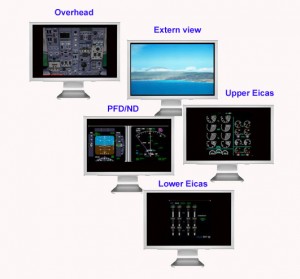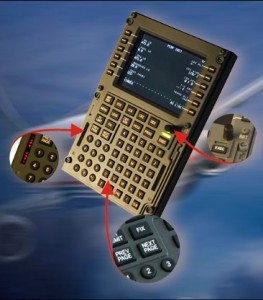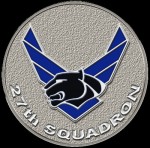PMDG Setup
At the beginning of this cockpitproject I have chosen a 737 cockpit build around the PMDG software.
The reason for this is quite simple : The PMDG 737-800 is a reliable and stable aircraft where the ability of the various displays ‘undocken’ and to move to different monitors.
- External view FS;
- Primary Flight Display (PFD);
- Navigation Display (ND);
- Upper Eicas (and Lower Eicas);
- Overhead.
It was still that for all the hardware necessary PMDG drivers are available were to have a full cockpit.
The hardware capabilities are only limited to the possibilities one can find in the PMDG software. Not more or not less.
With the use of independent flightdeck-software such as Project Magenta, Flight Deck Software, Sim Avionics, or ProSim737 is the computersetup often extensive and complex. Several pcs are then necessary for the cockpit displays for, amongst PFD, ND and Eicas. Not to mention the various integrated software add-ons to these 737-suites (MCP, CDU, Efis, Overhead and Logics!).
At the time of this writing, none of these software packages completely or perfectly. The evolution of this particular Boeing-Suites should reveal which package I in the future will choose, and when the transition will happen.
.
*** In the meantime (July 15, 2011), this transition happened to the Boeing-Suite PROSIM737 ***
.
More information about ProSim737 is to be found on page Software/ProSim737 Setup.
.
WINDOWS MONITORS SETUP
The placing of the screens in windows requires a bit of patience and precision work. The screens must be all in the right place in windows to the mouse cursor the right way to follow t.o.v. the actual position of the different hardware screens.
Also, attention must be paid they are not too close to each other so as to increase the ‘sleep’ in windows. Otherwise you'll get an overlap.
The place of the ‘sleep’ windows of the PFD, ND, Upper and Lower Eicas is also adaptation work. The white edges of the windows are always visible and can be hidden behind the MIP front, but then some parts of the displays invisible. The top edge of each window you can have the appearance of windows in colouring in a black color.
.
.
The driver of Flight Sim Labs offers the possible to the CPFlight MCP hardware and Efis to use with the PMDG737NG (800-900 airliners addon is necessary).
This driver only works with FS2004 where the driver is a virtual COM port created in the FS-menu, and then you have the right COM-port can fill in which the CPFlight hardware is connected.
There is also ensured that the ICS-FlyEngravity MIP compatible with this software. M. a.w. all the working functions in the PMDG-MIP also work in ICS FlyEngravity MIP.
Which modules of CP Flight work :
Radio Stack
- VHF1, VHF 2 modules
- NAV1, NAV2 modules
- ADF1, ADF2 modules
- XPDR module
Mip
- Autobrakes
- Fire Warning
- Master Caution
- Six Pack warning lights
- Flaps Lights
- Gear Lights
- Test Panel
- SPD Ref
- N1 Knobs
- Fuel Flow
.
The PMDG-737 CDU, one can associate with this hardware CDU from FlyEngravity and this through a driver PMDG. Unfortunately, this driver no longer available on the PMDG site.
This driver consists of a interfaceprogramma and a license key from PMDG.
Through this program and the insertion of the key is a virtual port created so that you the COM-port you can choose to which the CDU is connected.
.
*** Download PMDG Interface Program ***
.
After the startup of FS9 (FS9!) and the loading of the 737-PMDG plane, light in the display and the data of the PMDG-CDU projected to be in the hardware CDU. All you can do, such as in the PMDG-CDU, only there is a small ‘delay’ t.o.v. the softversie.
- All the buttons such as the keypad, LSK and RSK keys are illuminated;
- The ‘Annunciators’ with ‘Msg’-message lights on after e.g. the end of the route or with too little fuel;
- The execute led starts to burn in accordance with the PMDG-CDU;
- With a rotary encoder can be backlightverlichting adjust;
- When pressing the buttons to hear a click sound. This sound one can possibly drop off or adjust volume
.
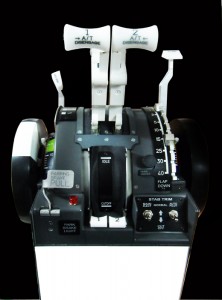 REVOLUTION SIMPRODUCTS TQ WITH PMDG SIOC SCRIPT
REVOLUTION SIMPRODUCTS TQ WITH PMDG SIOC SCRIPT
As I've already mentioned SIOC a software program that serves to all kinds of cockpithardware to send. This management is done by the transfer (loading) of a SIOC-script.
For the control of this TQ we have, therefore, a personal SIOC-script necessary. This script is provided by Revolution Simproducts and also depends on what plane or flightdecksoftware package they used (PMDG, ProSim737, Project Magenta, Flight Deck Software, Sim Avionics). There is something for everyone ...
This adjustment in SIOC you can easily do it yourself. Several lines attach in the SIOC ini with the correct name of the script and the correct IDX and Device No. of the connected USB DC Motor controller after the connection reading in SIOC).
A version of SIOC can be downloaded from the Revolution Simproducts website or on the website of OpenCockpits.
The further configuration of the TQ, with no specific PMDG-settings are required, can be found on page Hardware/Throttle Quadrant.
.
Calibration and adjusting of the axes DC Motor(s)
- Throttle Liver 1 and 2
- Trim Wheels
- Trim Indicators
- Speed Brakes
- Flaps
This calibration and afregelingen for the axes controlled by the DCMotor and is carried out remotely by someone from Revolution-Simproducts (Oral Barkay).
This happens with Skype and Crossloop. Skype is, as everyone knows, our online phone and Crossloop is a freeware program to remotely another computer to take over.
Changes need to happen in the Sioc ini and Sioc-PMDG-script. The screen, and the conscious files are overnomen, adjusted and tested. I just need to pass it via Skype what happens to the TQ during the aftuning. Of course this happens in a test flight.
This calibration and aftuning lasted +- 1½Hr.
And not to forget : Thanks to the Revolution Simproducts Team (Oral Barkay) for the excellent service !
.
*** Download Manual Revolution Simproducts TQ – Version PMDG ***
Translated by Yandex.Translate and Global Translator

